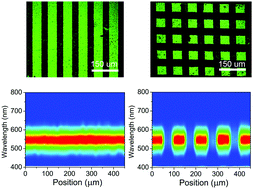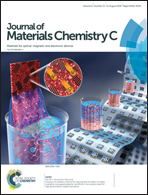Rewritable and highly stable photonic patterns for optical storage and display enabled by direct-pressure-programmed shape memory photonic crystals†
Abstract
This work presents the fabrication of rewritable and highly stable photonic patterns with high spatial resolution and applications in data storage and display panels, based on direct-pressure-programmed polyethylene glycol diacrylate (PEGDA) and polyurethane acrylate (TAPU) copolymer shape memory photonic crystals (SMPCs). Because of the existence of cross-linked polyurethane units and reversible plastic strain on the nanoscale, PEGDA-co-TAPU SMPCs exhibit high optical reversibility, excellent stability, and direct pressure-induced programming ability at room temperature. By taking advantage of these characteristics, various rewritable and highly stable photonic patterns are accurately fabricated at high resolution via imprinting lithography under ambient conditions. Notably, multiple optical microarray patterns can be created by sequential imprinting. These created photonic patterns are used as novel optically readable media for optical data storage and display panels by designing macro/microstructures. The SMPCs provide a new optical platform for the fabrication of rewritable and highly stable photonic patterns. Meanwhile, we anticipate that these photonic patterns could be further extended to the development of reusable photonic devices and sensors.



 Please wait while we load your content...
Please wait while we load your content...